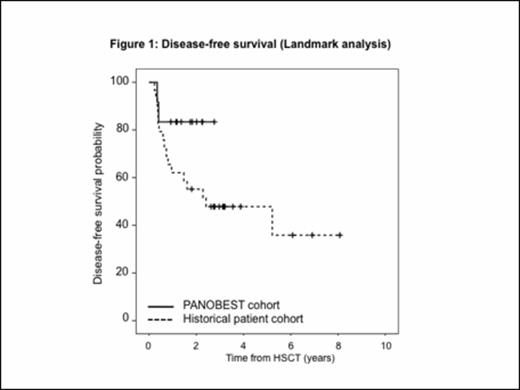Abstract
Inhibitors of class I/II histone deacetylases (HDACi) possess anti-leukemic activity and have been reported to modulate the function of immune effector cells. Thus, they could provide specific clinical benefit in the allogeneic hematopoietic stem cell transplantation (HSCT) setting. Panobinostat (PAN) is a potent, orally available pan-HDACi reported to either suppress or stimulate regulatory T cells (T reg), depending on the administered dose (Shen L & Pili R, OncoImmunology 1;7:948, 2012). The feasibility and efficacy of PAN treatment following HSCT for patients (pts) with high risk acute myeloid leukemia (AML) has not been established. We report clinical and translational results of the dose-escalation phase of the PANOBEST study with PAN as post-HSCT maintenance.
Primary objectives were, based on dose-limiting toxicity (DLT), determining the maximum tolerated dose (MTD) and/or the recommended phase 2 dose (RP2D) of PAN in patients with high risk AML or myelodysplastic syndromes (MDS) in complete remission (CR) after reduced-intensity conditioning HSCT. Secondary objectives were the evaluation of safety, tolerability and immunoregulatory properties of PAN, and overall (OS) and disease-free survival (DFS) of treated patients.
PAN was started at 10 mg p.o. three times a week (TIW) and escalated to 20 and 30 mg TIW using a 3+3 design. Treatment was initiated 60-150 days after HSCT and continued for up to one year. Eligibility criteria included: recovery of peripheral blood counts, adequate organ function and no severe graft versus host disease (GvHD). All pts gave written informed consent. DLT was defined as prolonged grade 4 hematologic or grade 3/4 non-hematologic toxicity within 28 days of the first PAN dose. Immunophenoytyping of lymphocyte subsets was performed pre-treatment and on days 3, 8, 30, 90, 180 and 360.
PAN is well tolerated after HSCT at a RP2D of 20 mg TIW. Comparison with a historical control cohort of pts transplanted with active AML shows a low relapse rate, which appears to be associated with a PAN-induced modulation of the T reg/Th proportion.
Bug:Novartis: Honoraria, Travel grants, support for the clinical study Other. Ottmann:Novartis: Consultancy, Membership on an entity’s Board of Directors or advisory committees, Research Funding, Speakers Bureau.
Author notes
Asterisk with author names denotes non-ASH members.


